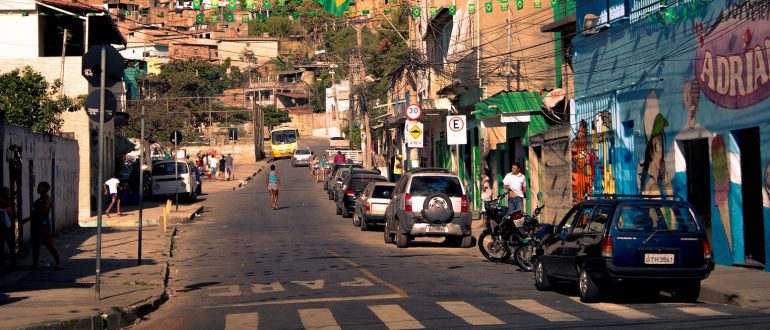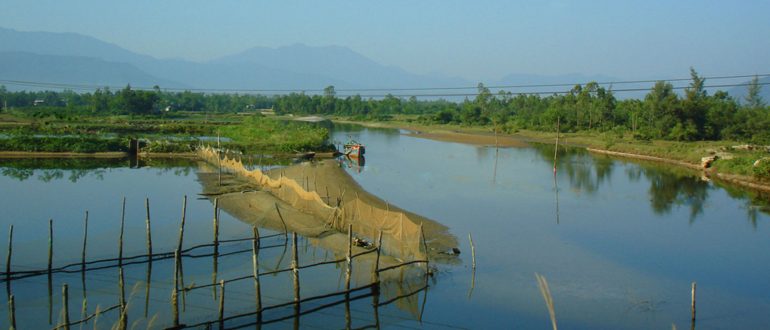
LACalytics: Building Bridges – Drawing Borders
“Any law that the people have not ratified in person is void, is not law at all.“ (Jean-Jacques Rousseau, The Social Contract 1763)
Micro-level case study: Brazilian Inequality and Social Stratification
“Building Bridges: Drawing Borders” compares the lives of two young women who grew up in neighbouring municipalities in the state of São Paulo, Brazil. Urban segregation, dividing the megalopolis into favelas (shanty towns) and gated communities, reflect the social inequality between them. In spite of the introduction of more integrative policies in the past, the underlying problem remains the same: Because of a gap between the rich and poor, the majority of Brazilians miss the opportunity to improve their quality of life in the long run.
There are several similarities Jessika, 27, and Ana, 28, share: both of them grew up in the Northwestern outskirts of the metropolitan área of São Paulo. Their childhood homes in Centro, Carapicuíba, and Alphaville, Barueri, are located in immediate proximity divided by a bridge. Still, there are differences regarding their family backgrounds, available financial resources as well as their access to quality education. Their wishes for the future require a strong family structure and access to a solid school system to be able to enter the competitive job market.
The two women have similar hopes for the future, but not the same chances. What can be done to break this vicious cycle which predetermines the socioeconomic status quo of the less privileged?
Social inequality in Brazil
The unequal distribution of resources in Brazil originates in the colonial era. The enslavement of African natives led to a division of the Brazilian society into latifundistas (property owners) and slaves. Initially based on race, social inequality was further entrenched through weak property rights protection over centuries. In the 20th century, after twenty one years of dictatorship and a ‘lost decade’ thereafter, marked by inflation and neoliberal policies, the income gap grew exponentially. During the democratization in the 1980s, the political make-up changed and mass migration was followed by ghettoization as a side effect of unsustainable urbanization. An enlargement of the informal sector excluded numerous citizens from the welfare system. Today, favelas and gated communities depict a pattern of segregation by class and status.
Against this background, Jessika and Ana answered interview questions concerning their family history, education, occupation, household income, dependents, savings and future dreams. Race and ethnicity are neglected as determinants for social inequality, since both women are white Brazilians of European descent.
Jessika, 27, has been living with her partner for ten years in Carapicuíba, where she grew up. She was pregnant with her third child when the interview was conducted (February 2016). Conscious of her childhood showing a rather dysfunctional family structure, Jessika shared that the separation of her parents, changing partners and stepsiblings caused unstable family relations. Hoping “to be a present mother”, she does “not want to fail like [my] mother did.” Jessika always saw her mother “as a sister who did fun things, but never checked [my] homework nor took [me] to school”, while she was being raised by her grandmother and aunts. She attended public schools, but did not complete high school later on. Jessika worked as a telemarketer for two years but is now unemployed. Although dreaming of going back to school to build a career, she admitted that her children are her top priority. She longs for having a night-out with girlfriends: “I don’t remember the last time I did something fun, now I would need a liposuction in order to dress up!”
In comparison, Ana, 28, lives in Vila Madalena, one of the trendiest areas of São Paulo. As the youngest of four, she was raised by both of her parents in the gated community Alphaville, in Barueri. After graduating with a master’s degree, Ana has been working as an architect and plans to adopt a child in the future. She stated: “I studied in a semi-private school, and earned my degree from the University of São Paulo. I would like my children to have access to the same opportunities.” Ana is an independent woman, excited about her new idea of designing exotic wooden chairs. She enjoys everyday life having fun with friends around the city and is planning her next trip abroad.
In Brazil, the number of graduates has been growing from 4% in 1982 to 11% in 2009, due to the liberalization of the regulatory system through quotas and government programmes like Pro-Uni providing scholarships to students in private universities. As a consequence parallel structures of private and public services have developed.
Many people with good economic conditions prefer private primary schooling. Public and federal universities in Brazil, however, enjoy a much higher recognition than private ones. They are free of charge, but it requires candidates to go through a competitive exam (vestibular) which, in the majority of cases, only students from private schools pass successfully. Ana’s household income amounts to approximately R$ 3,000 (approx. € 750), almost twice as much as Jessika’s. She plans on having her children educated in private schools, whereas Jessika cannot afford this luxury.
Social programs improving the lives of the poor
The differences in living conditions of Jessika and Ana are comprehensible knowing that historically the access to public services differed and is still bound by the available financial resources. Brazil underwent rapid economic growth after the turn of the millennium. Since 2003, an inclusion of the underprivileged has been observed, after former President Lula da Silva (Worker’s Party, in office from 2003 to 2011) had introduced a set of social policies. As a result of the conditional cash transfer program Bolsa Família, which links school attendance to a grant, there was an increase in schooling from 5.8 to 8.3 years, representing a 42% hike from 1995 to 2009. Other achievements related to Bolsa Família include the expansion of rights (access to social services through formal citizenship), the reduction of child labour, a notable improvement of nutrition and coordination among ministries in education and health. Jessika is a recipient of the monthly grant of R$ 236 (approx. € 63) for which sending her children to primary school is a precondition.
Although these types of social programs have greatly improved the lives of many households, the quality of such must still be honed. Bolsa Família has the potential to be expanded and improved as its application process has been perceived complicated by beneficiaries and government spending remained low. Also, there is no strategy to enhance independence of families in the long run.
While the conservative opposition is hesitant on the inclusion of people by decree, President Dilma Rousseff (Worker’s Party, in office since 2011) introduced further social programs. For instance, quotas requiring federal public universities to reserve half of admission spots for underprivileged students were introduced. However, based on a longstanding belief in meritocracy, critical voices were raised on inclusive measures. Racism is another underlying reason why social inequality and stratification is still preserved in Brazil. Even though the country’s flag carries the phrase “Order and Progress”, Brazilians have been facing stagnation of the status quo and a lack of social development.
A vicious cycle determines future expectations before birth. Jessika’s concerns regarding her children’s future are justified. Access to education is strongly associated with family income: One additional year of parents’ education prolongs their children’s education by approximately 0.27 years. Sports and arts also play an important role in societal development. Many children are sent to soccer, volley, ballet or music schools with the hope of a shift in the family prospects as stars like the soccer players Marta and Neymar have accomplished.
Although this comparison between only two women risks generalizations, it has revealed that factors like gender, socioeconomic background and level of education, occupation and region influence social inequality. It thus becomes evident that poverty is not self-inflicted. In reality, the less fortunate experience a discriminatory cycle that is hard to break free from.
Education, media and economy remain challenges
Current trends point to an alleviation of inequality due to the rise of the middle class based on economic growth. An increase of wages enabling the reallocation of resources, like the monthly minimum wage increase since 1995 led to a decline in the poverty rate. Additionally, the rise of women in the workforce since the beginning of the 1980s has pushed to a soft shift towards progress, yet there remains a need for reduction in social inequality. One could hope that Jessika’s children will be able to choose from different options in their lives. But this will depend on current trends to remain on the rise, which cannot be taken for granted.
There are three main challenges regarding the alleviation of social inequality in Brazil. Due to a limited access to quality education, there is a lack of social mobility within society. As mentioned before, education is a key element to affect change in society and end political exclusion. The underlying structures of biased media alienating the masses and corrupt politicians show that the young democracy is still undermined by nepotism. Also, economic growth recently suffered from decreasing commodity prices. Lastly, higher pensions and unproductive tax breaks led to a fiscal deficit from 2% of GDP in 2010 to 10% in 2015.
Taking the right steps into the future
Based on the recent demographic change accompanied by more women in the workforce, a reduction in birth rates and a higher number of formal jobs, Brazil carries hope as a prominent regional powerhouse. For this to hope to turn reality, some additional steps should be taken. First, the economy would benefit from the integration of additional women in the workforce. Missing financial means, Jessika described her life course like a series of events rather than expressing the self-determination of Ana. Second, public schools should adopt sex education and family planning programs to prevent teenage pregnancies and enhance their independence. Along with this measure, abortion rights need to be reformed to empower women with the right to choice. Essentially, if the government does not invest in quality education (teacher training, higher wages for staff etc.), there will be no substantial change.
A third measure is to continue to formalize jobs, making sure that the maids and construction workers who cross the bridge between Carapicuíba and Alphaville have proper labour conditions including a reasonable salary, holidays and a decent work schedule. Such measures have been partially taken. Even though maids need to be paid minimum wage, yet there are households where they are exploited by their employers and receive much less. In this context, the rich who can afford house staff will need to increasingly contribute to the social development. Finally, they should be adequately taxed in order to facilitate a distribution of resources. The hope for “order and progress” as well as social and gender equality is decisive to break free from vicious cycles and to build bridges rather than drawing borders across Brazil.
This article was written as part of CISS’s LACalytics project, which brings together young experts from Latin America and the Caribbean with their European counterparts. In bi-regional teams authors develop analyses about issues within the fields of politics, environment, economics and civil society as well as about the EU -Latin American relations. Selected texts have been published by partner media. This article was first released by Blickpunkt Lateinamerika (German) and Xadrez Verbal (Portuguese).



